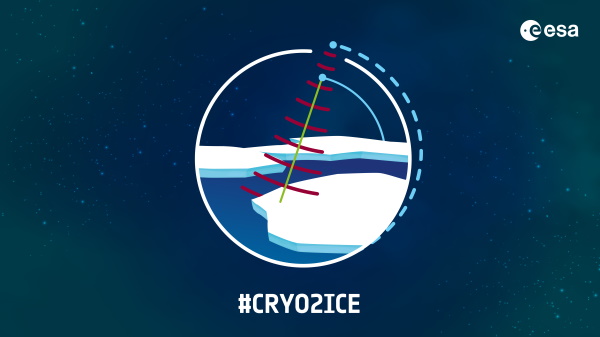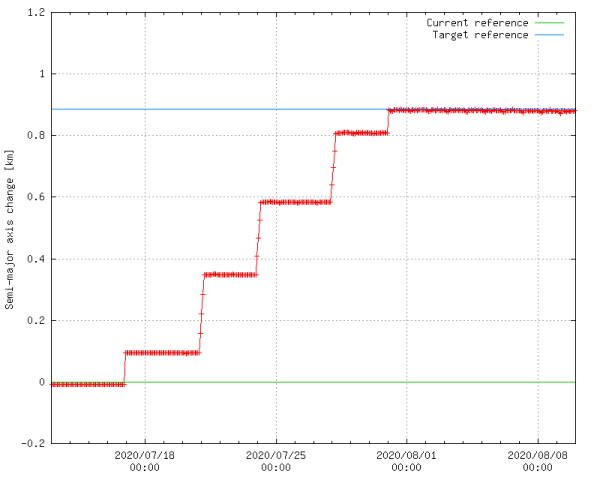- News & Events
- A Closer Look at CRYO2ICE Mano...
A Closer Look at CRYO2ICE Manoeuvres
16 Nov 2020
Between 16 and 31 July 2020, ESA raised the orbit of Earth Explorer CryoSat-2 to periodically align with NASA's ICESat-2 in a campaign dubbed CRYO2ICE. Its aim was to achieve a partial parallel ground-track every 19th revolution of CryoSat-2 and every 20th revolution of ICESat-2 that would allow data in the polar areas to be collected by the two satellites within a few hours of each other. To reach this goal, CryoSat-2's semi-major axis had to be increased by 887 meters through a series of manoeuvres.
The change provides radar and lidar measurements of the same ice, at nearly the same time, allowing scientists to improve the accuracy of sea ice thickness measurements and ice-sheet elevation time series. The new in-sync measurements will also help map snow over the poles and advance our understanding of currents in polar oceans, with further applications expected in the study of inland waters and the atmosphere.
The execution of the campaign was a joint effort between CryoSat's Mission Management and the Ground Operations team based in ESA's Centre for Earth Observation (ESRIN) in Italy, and the Flight Control Team (FCT), Flight Dynamics (FD) team and Space Debris Office (SDO) located at ESA's European Space Operations Centre (ESOC) in Germany.

How CRYO2ICE manoeuvres worked
14 manoeuvres were needed for CryoSat-2 to reach its new orbit. The first manoeuvre, executed on 16 July, was a test, followed by three batches of four manoeuvres. The last touch-up manoeuvre was executed on 30 July.
CRYO2ICE manoeuvres required excellent coordination between ESA's various operations and mission teams. The Flight Dynamics team first fine-tuned and optimised manoeuvres, then delivered the final orbit to the FCT and SDO. The Space Debris Office then screened the manoeuvre and verified any potential risk of collisions. After receiving the results of the screening from SDO, the mission manager gave the go-no-go for the manoeuvre.
Once the go ahead was given, the Flight Control Team, who sends commands to satellites and monitors their execution, took over. They uplinked the commands during CryoSat-2's overpass of Kiruna Station, in Sweden, where the satellite passes every 90 minutes. There were several backup time slots, in case the commands could not be transmitted during the first attempt.
After the commands were received by CryoSat, the process was automatic. The satellite went from fine point mode to orbit control mode and its instrument, the SAR/Interferometric Radar Altimeter (SIRAL), went into standby for the duration of the manoeuvres. The instrument's downtime did not significantly impact CryoSat-2 overall data collection and SIRAL data quality was continuously monitored by the CryoSat Quality Control team, the QA4EO-IDEAS consortium.

The thrusters were then fired and CryoSat-2 was raised into its new orbit. The duration of the firing differed between manoeuvres, with the first taking nearly 600 seconds and every manoeuvre of the 3rd batch approximately 320 seconds each. All 14 manoeuvres together consumed 0.48 kg of CryoSat-2's remaining fuel.
The next day, the Flight Control team verified that the manoeuvre took place and the commands were executed. Flight Dynamics then came back into play, checking where CryoSat-2 was, collecting data to reconstruct the orbit of the satellite and estimated how successful the manoeuvre was. The process then started again from the top, with the next manoeuvre.
CRYO2ICE manoeuvres execution
All fourteen manoeuvres of the campaign performed nominally, but it was not all smooth sailing in the Control Room. While checking the last orbit change, the Space Debris Office found a high risk of collision with debris and advised against executing the 14th manoeuvre.
The Flight Dynamics team stepped in and proposed a change in the timing of the manoeuvre, which would increase the distance from the debris at the time of closest approach. The change slightly modified the path of the manoeuvre, but helped avoid the risk of collision with debris and maintained the same characteristics in terms of target orbit. After being verified by SDO, the new orbit was deemed safe and the FD team worked around the clock to finalise the commands for the new manoeuvre and keep to the original campaign schedule. They succeeded and FCT was able to uplink the new commands as planned.
"Coordination played a fundamental role in the successful completion of the CRYO2ICE campaign," says Ignacio Clerigo, Head of the CryoSat-2/Swarm/Aeolus Missions Operations Unit. "Especially during manoeuvre 14, when the Collision Warning arose, all the teams worked quickly and efficiently together to find a solution that would ensure the campaign would be both successful and executed on schedule. This was especially challenging given the extraordinary circumstances we are currently operating on, without the possibility of face-to-face meetings, but the teams were able to overcome all obstacles."
Towards a new chapter for CryoSat
With the CRYO2ICE campaign successfully completed, it is now up to the scientists to make use of the wealth of new possibilities unlocked by the near-synchronous orbit of the two satellites.
"The scientific benefits such a small orbit change for CryoSat will bring are impressive," says Tommaso Parrinello, CryoSat Mission Manager. "By using the combined data from CryoSat-2's radar and ICESat-2's laser instruments, for the first time, we will be able to reduce inaccuracies in sea ice thickness and land ice measurements. It will enable us to map snow at the poles and could help us, among other aspects, to measure sea ice in summer and improve climate models."
The first results are expected to be presented next year during the CryoSat 10th Anniversary Science Conference, taking place 14-17 June 2021.